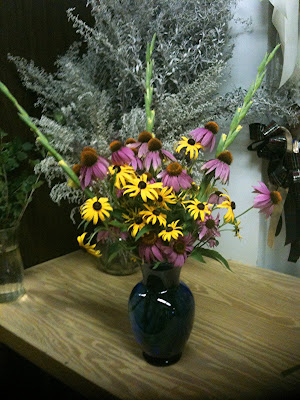Aside from a handful of extremely hot and humid days in July and a few dry weeks, Wisconsin weather has been near perfect this summer. I’m grateful for this.
Now we’re traveling down the path toward autumn, and it’s time to reflect on gardening lessons from the summer of 2011.
Among them (some personal and some universal):
1. Cover bulbs with lava rocks and plant onion sets among the annuals. I’ve tried so many techniques over the years to keep rabbits, squirrels, and chipmunks out of my plants (with mixed results). I wondered why I kept finding lava rocks in a couple of the garden beds. And after my Hyacinth bulbs were upended for the fourth time, I decided to stack lava rocks on top of them. Lo and behold—no more digging! So I bought a bag of lava rocks and plan to top all my bulbs this way. And I’ve known for years that onion sets repel critters but I’ve never planted them in pots among annuals before. The pots looked a little silly at first, but as the annuals filled in around them the onion greens were barely noticeable. These two tricks—lava rocks and onion sets—really work!
2. Resist the urge to water plants every day during a dry spell. With the exception of potted annuals and bright sunny gardens, most plants survive just fine without water for a few days. Then when a drought hits, they've developed deeper roots to handle the shortage of rain. Granted, we didn’t have a severe drought in southern Wisconsin
3. Take stock of color. My garden has plenty of color except for a very short stretch in mid-August. My solution: I’m planning to plant annuals or perennials that will bloom during this time. I haven’t decided which ones yet, but thanks to all the great suggestions from gardeners, garden bloggers, and Blotanical members, I have some great ideas. I’m also adding a few garden decorations. I tend to be Spartan and naturalistic in my garden design, but these light touches will bring pops of color—even in the depths of winter.
4. Take time to simply sit on the porch or in a quiet place, suck in the fresh air, listen to the critters, and relax. Even if you’re extremely busy like I was this summer, you can spare at least 30 minutes a week to simply enjoy your garden without rushing around and toiling. I learned this lesson years ago, but I had to make a special effort to practice it during this particularly hectic summer.
To help me with Nos. 3 and 4 above, my husband made this sweet garden bench, which we placed at the end of our wooded path. It’s perfect for reflecting on nature’s beauty at any time of year.
What about you? What garden lessons have you learned during the summer of 2011? Please link a recent post about your summer advice, reflections, or ideas to the Garden Lessons Learned Mr. Linky meme below. Happy (almost) autumn!





















